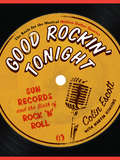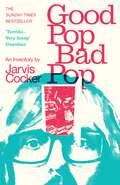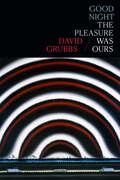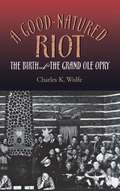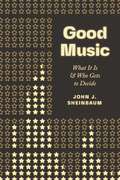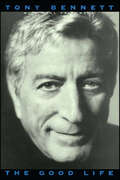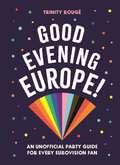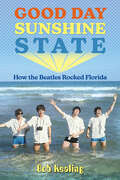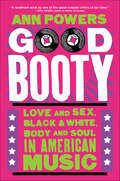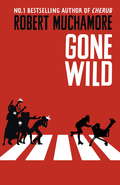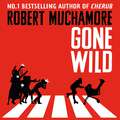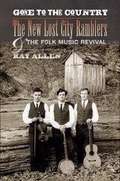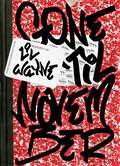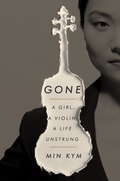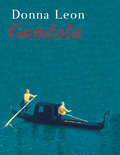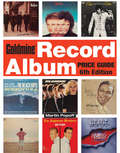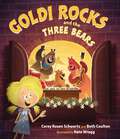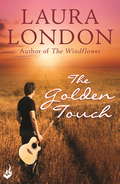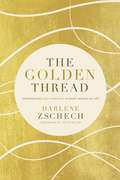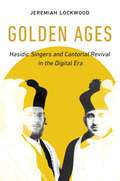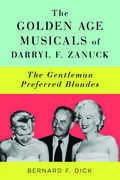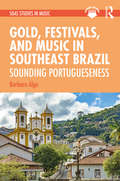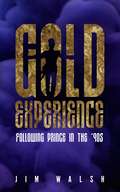- Table View
- List View
Good Rockin' Tonight
by Colin Escott Martin HawkinsRock 'n' roll was born in Memphis in the tiny storefront recording studio of Sun Records. <P><P>This is the definitive account of how it happened! Sam Phillips's credo was: "If you're not doing something different, you're not doing anything." <P> If he had done no more than discover Elvis Presley and produce his first five singles he would still be the godfather of rock 'n' roll. But he did more. <P>Much more. While Elvis was still sitting on the edge of his bed listening to the radio and figuring out guitar chords, Phillips was discovering and recording blues giants like B.B. King, Howling Wolf, and Ike Turner. <P>During the few months that Elvis was with Sun Records, Phillips found Johnny Cash and Carl Perkins. Soon after, he found Jerry Lee Lewis, Roy Orbison, and Charlie Rich. <P>And he did it almost singlehandedly--from his two-room studio in Memphis, Tennessee. <P> Phillips's story, which Colin Escott tells in beautiful detail, is more than a catalog of hits. <P>Without Sun's philosophy of experimentation, innovation, and genre transcendence, the musical revolution could have never begun.
Good Pop, Bad Pop: The Sunday Times bestselling hit from Jarvis Cocker
by Jarvis CockerThe Sunday Times bestselling hit memoir from Pulp frontman Jarvis Cocker.'It's real gold... its storytelling first class' Sunday TimesWhat if the things we keep hidden say more about us than those we put on display?We all have a random collection of the things that made us - photos, tickets, clothes, souvenirs, stuffed in a box, packed in a suitcase, crammed into a drawer. When Jarvis Cocker starts clearing out his loft, he finds a jumble of objects that catalogue his story and ask him some awkward questions:Who do you think you are?Are clothes important?Why are there so many pairs of broken glasses up here?From a Gold Star polycotton shirt to a pack of Wrigley's Extra, from his teenage attempts to write songs to the Sexy Laughs Fantastic Dirty Joke Book, this is the hard evidence of Jarvis's unique life, Pulp, 20th century pop culture, the good times and the mistakes he'd rather forget.This is not a life story. It's a loft story.'Nostalgic, playful and beautifully designed' Daily Mail'Brilliant...lurid, entertaining' Daily Telegraph'Terrific... Very funny' Guardian* A Book of the Year in the Daily Telegraph, Financial Times, Daily Mail and Uncut *
Good night the pleasure was ours
by David GrubbsWith Good night the pleasure was ours, David Grubbs melts down and recasts three decades of playing music on tour into a book-length poem, bringing to a close the trilogy that includes Now that the audience is assembled and The Voice in the Headphones. In Good night the pleasure was ours, the world outside the tour filters in with eccentric sparseness. From teenage punk bands to ensembles without fixed membership, and from solo performance to a group augmented by digital avatars, Grubbs presents touring as a series of daily dislocations that provides an education distinctly its own. These musicians’ job is to play that evening’s gig—whether to enthusiastic, hostile, or apathetic audiences—and then to do it again the next day. And yet, over the course of the book’s multidecade arc, Grubbs depicts music making as an irreversible process—one reason for loving it so.
A Good-Natured Riot: The Birth of the Grand Ole Opry (Co-published with the Country Music Foundation Press)
by Charles K. WolfeWinner of the Ralph J. Gleason Music Book AwardWinner of the ASCAP Deems Taylor AwardOn November 28, 1925, a white-bearded man sat before one of Nashville radio station WSM's newfangled carbon microphones to play a few old-time fiddle tunes. Uncle Jimmy Thompson played on the air for an hour that night, and throughout the region listeners at their old crystal sets suddenly perked up. Back in Nashville the response at the offices of National Life Insurance Company, which owned radio station WSM ("We Shield Millions"), was dramatic; phone calls and telegrams poured into the station, many of them making special requests. It was not long before station manager George D. Hay was besieged by pickers and fiddlers of every variety, as well as hoedown bands, singers, and comedians—all wanting their shot at the Saturday night airwaves. "We soon had a good-natured riot on our hands," Hay later recalled. And, thus, the Opry was born.Or so the story goes. In truth, the birth of the Opry was a far more complicated event than even Hay, "the solemn old Judge," remembered. The veteran performers of that era are all gone now, but since the 1970s pioneering country music historian Charles K. Wolfe has spent countless hours recording the oral history of the principals and their families and mining archival materials from the Country Music Foundation and elsewhere to understand just what those early days were like. The story that he has reconstructed is fascinating. Both a detailed history and a group biography of the Opry's early years, A Good-Natured Riot provides the first comprehensive and thoroughly researched account of the personalities, the music, and the social and cultural conditions that were such fertile ground for the growth of a radio show that was to become an essential part of American culture.Wolfe traces the unsure beginnings of the Opry through its many incarnations, through cast tours of the South, the Great Depression, commercial sponsorship by companies like Prince Albert Tobacco, and the first national radio linkups. He gives colorful and engaging portraits of the motley assembly of the first Opry casts—amateurs from the hills and valleys surrounding Nashville, like harmonica player Dr. Humphrey Bate ("Dean of the Opry") and fiddler Sid Harkreader, virtuoso string bands like the Dixieliners, colorful hoedown bands like the Gully Jumpers and the Fruit Jar Drinkers, the important African American performer DeFord Bailey, vaudeville acts and comedians like Lasses and Honey, through more professional groups such as the Vagabonds, the Delmore Brothers, Bill Monroe and the Blue Grass Boys, and perennial favorite Roy Acuff and his Smoky Mountain Boys.With dozens of wonderful photographs and a complete roster of every performer and performance of these early Opry years, A Good-Natured Riot gives a full and authoritative portrayal of the colorful beginnings of WSM's barn dance program up to 1940, by which time the Grand Ole Opry had found its national audience and was poised to become the legendary institution that it remains to this day.
A Good-Natured Riot: The Birth of the Grand Ole Opry (Co-published with the Country Music Foundation Press)
by Charles K. WolfeWinner of the Ralph J. Gleason Music Book AwardWinner of the ASCAP Deems Taylor Award On November 28, 1925, a white-bearded man sat before one of Nashville radio station WSM's newfangled carbon microphones to play a few old-time fiddle tunes. Uncle Jimmy Thompson played on the air for an hour that night, and throughout the region listeners at their old crystal sets suddenly perked up. Back in Nashville the response at the offices of National Life Insurance Company, which owned radio station WSM ("We Shield Millions"), was dramatic; phone calls and telegrams poured into the station, many of them making special requests. It was not long before station manager George D. Hay was besieged by pickers and fiddlers of every variety, as well as hoedown bands, singers, and comedians--all wanting their shot at the Saturday night airwaves. "We soon had a good-natured riot on our hands," Hay later recalled. And, thus, the Opry was born. Or so the story goes. In truth, the birth of the Opry was a far more complicated event than even Hay, "the solemn old Judge," remembered. The veteran performers of that era are all gone now, but since the 1970s pioneering country music historian Charles K. Wolfe has spent countless hours recording the oral history of the principals and their families and mining archival materials from the Country Music Foundation and elsewhere to understand just what those early days were like. The story that he has reconstructed is fascinating. Both a detailed history and a group biography of the Opry's early years, A Good-Natured Riot provides the first comprehensive and thoroughly researched account of the personalities, the music, and the social and cultural conditions that were such fertile ground for the growth of a radio show that was to become an essential part of American culture. Wolfe traces the unsure beginnings of the Opry through its many incarnations, through cast tours of the South, the Great Depression, commercial sponsorship by companies like Prince Albert Tobacco, and the first national radio linkups. He gives colorful and engaging portraits of the motley assembly of the first Opry casts--amateurs from the hills and valleys surrounding Nashville, like harmonica player Dr. Humphrey Bate ("Dean of the Opry") and fiddler Sid Harkreader, virtuoso string bands like the Dixieliners, colorful hoedown bands like the Gully Jumpers and the Fruit Jar Drinkers, the important African American performer DeFord Bailey, vaudeville acts and comedians like Lasses and Honey, through more professional groups such as the Vagabonds, the Delmore Brothers, Bill Monroe and the Blue Grass Boys, and perennial favorite Roy Acuff and his Smoky Mountain Boys. With dozens of wonderful photographs and a complete roster of every performer and performance of these early Opry years, A Good-Natured Riot gives a full and authoritative portrayal of the colorful beginnings of WSM's barn dance program up to 1940, by which time the Grand Ole Opry had found its national audience and was poised to become the legendary institution that it remains to this day.
Good Music: What It Is and Who Gets to Decide
by John J. SheinbaumOver the past two centuries Western culture has largely valorized a particular kind of “good” music—highly serious, wondrously deep, stylistically authentic, heroically created, and strikingly original—and, at the same time, has marginalized music that does not live up to those ideals. In Good Music, John J. Sheinbaum explores these traditional models for valuing music. By engaging examples such as Handel oratorios, Beethoven and Mahler symphonies, jazz improvisations, Bruce Springsteen, and prog rock, he argues that metaphors of perfection do justice to neither the perceived strengths nor the assumed weaknesses of the music in question. Instead, he proposes an alternative model of appreciation where abstract notions of virtue need not dictate our understanding. Good music can, with pride, be playful rather than serious, diverse rather than unified, engaging to both body and mind, in dialogue with manifold styles and genres, and collaborative to the core. We can widen the scope of what music we value and reconsider the conventional rituals surrounding it, while retaining the joys of making music, listening closely, and caring passionately.
The Good Life: The Autobiography Of Tony Bennett
by Tony Bennett Will FriedwaldA wonderfully warm, resonant, and captivating autobiography from iconic singer and entertainer Tony Bennett.He&’s that regular guy from Astoria, Queens, who left his heart in San Francisco. He&’s the postwar heartthrob who inspired hundreds of young girls to wear black outside St. Patrick&’s Cathedral on his wedding day. He&’s the darling of the MTV generation who made music history when, at the age of 68, he won the coveted Grammy Award for Album of the Year. He&’s the consummate artist known worldwide for his paintings. He&’s Tony Bennett, and here, this legend shares his amazing life story. &“Tony Bennett has not just bridged the generation gap, he has demolished it,&” praised The New York Times. From his appearance with the Red Hot Chili Peppers at the 1993 MTV Video Awards to his Radio City Music Hall concert with Lady Gaga, Bennett was the hottest—and coolest—pop-culture icon for today&’s younger listeners, while remaining beloved by their parents and grandparents. Multiple generations have experienced the Tony Bennett magic—the mesmerizing spell of a singer in love with singing, who embraces his audience with a soulful serenity communicated by both the man and his music. Honored with countless awards and with more than ninety albums to his credit, no other recording artist has attained Bennett&’s stature—or garnered the half-century of memories shared in The Good Life. From Sinatra, Judy Garland and Ella Fitzgerald, to k.d. lang and Elvis Costello, Bennett shares his unique takes on the most fascinating talents of our time. Here is the story of his lifelong love affair with art, music, and performing—from his childhood in Depression-era Queens, where opera and Billie Holiday flowed freely; to his stint as a singing waiter; to soaking up the New York jazz scene in the 1940s. With crisp wit and firmly grounded emotion, Bennett captures the people and places that shaped his sublime performances. The dozens of hits he introduced to the great American songbook, including &“Because of You,&” &“Rags to Riches,&” &“Cold, Cold Heart,&” and his signature song, &“I Left My Heart in San Francisco,&” remain a legacy of truth and beauty for the classic art of intimate singing. In this unforgettable self-portrait, we get to know Tony Bennett as he really is: an unpretentious and thoughtful human being. Through all of his personal and artistic challenges, he was, in his own words, &“a humanist&” whose Zen-like philosophy of life remains an inspiration for all ages. Like the fascinating story he shares in The Good Life, Tony Bennett was one of a kind, an American treasure, an enduring artist seasoned with experience and self-knowledge, and a true class act.
Good Evening Europe!: An unofficial party guide for every Eurovision fan
by Pyramid Trinity RougéFrom the good, the bad and the downright extraordinary, the Eurovision Song Contest is more than just one night of the year, it's a celebration of all things fabulous. This handy little guide is jam-packed with a myriad of Eurovision ideas to help you get your party started and guarantee yourself a great celebration that's as weird and wonderful as the acts themselves.So, get ready for questionable outfits, hilarious sassy commentary and lots of feathers.This isn't the time to be formal or trendy - focus on flamboyance and tackiness in large doses. Lay on the cheese as thickly as you can, and you won't go far wrong!
Good Evening Europe!: An unofficial party guide for every Eurovision fan
by Pyramid Trinity RougéFrom the good, the bad and the downright extraordinary, the Eurovision Song Contest is more than just one night of the year, it's a celebration of all things fabulous. This handy little guide is jam-packed with a myriad of Eurovision ideas to help you get your party started and guarantee yourself a great celebration that's as weird and wonderful as the acts themselves.So, get ready for questionable outfits, hilarious sassy commentary and lots of feathers.This isn't the time to be formal or trendy - focus on flamboyance and tackiness in large doses. Lay on the cheese as thickly as you can, and you won't go far wrong!
Good Day Sunshine State: How the Beatles Rocked Florida
by Bob KealingThe musical and cultural impact of the Fab Four in Florida In 1964, Beatlemania flooded the United States. The Beatles appeared live on the Ed Sullivan Show and embarked on their first tour of North America—and they spent more time in Florida than anywhere else. Good Day Sunshine State dives into this momentous time and place, exploring the band’s seismic influence on the people and culture of the state. Bob Kealing sets the historical stage for the band’s arrival—a nation dazed after the assassination of John F. Kennedy and on the precipice of the Vietnam War; a heavily segregated, conservative South; and in Florida, recent events that included the Cuban Missile Crisis and the arrest and imprisonment of Martin Luther King Jr. in St. Augustine. Kealing documents the culture clashes and unexpected affinities that emerged as the British rockers drew crowds, grew from fluff story to the subject of continual news coverage, and basked in the devotion of a young and idealistic generation. Through an abundance of letters, memorabilia, and interviews with journalists, fellow musicians, and fans, Kealing takes readers behind the scenes into the Beatles’ time in locations such as Miami Beach, where they wrote new songs and met Muhammad Ali. In the tropical environs of Key West, John Lennon and Paul McCartney experienced milestone moments in their friendship. And the band dodged the path of Hurricane Dora to play at the Gator Bowl in Jacksonville, where they famously refused to perform until the city agreed to integrate the audience. Kealing highlights the hopeful futures that the Beatles helped inspire, including stories of iconic rock-and-rollers such as Tom Petty who followed the band’s lead in their own paths to stardom. This book offers a close look at an important part of the musical and cultural revolution that helped make the Fab Four a worldwide phenomenon.Funding for this publication was provided through a grant from Florida Humanities with funds from the National Endowment for the Humanities. Any views, findings, conclusions or recommendations expressed in this publication do not necessarily represent those of Florida Humanities or the National Endowment for the Humanities.
Good Booty: Love and Sex, Black & White, Body and Soul in American Music
by Ann PowersNPR Best Books of 2017In this sweeping history of popular music in the United States, NPR’s acclaimed music critic examines how popular music shapes fundamental American ideas and beliefs, allowing us to communicate difficult emotions and truths about our most fraught social issues, most notably sex and race.In Good Booty, Ann Powers explores how popular music became America’s primary erotic art form. Powers takes us from nineteenth-century New Orleans through dance-crazed Jazz Age New York to the teen scream years of mid-twentieth century rock-and-roll to the cutting-edge adventures of today’s web-based pop stars. Drawing on her deep knowledge and insights on gender and sexuality, Powers recounts stories of forbidden lovers, wild shimmy-shakers, orgasmic gospel singers, countercultural perverts, soft-rock sensitivos, punk Puritans, and the cyborg known as Britney Spears to illuminate how eroticism—not merely sex, but love, bodily freedom, and liberating joy—became entwined within the rhythms and melodies of American song. This cohesion, she reveals, touches the heart of America's anxieties and hopes about race, feminism, marriage, youth, and freedom. In a survey that spans more than a century of music, Powers both heralds little known artists such as Florence Mills, a contemporary of Josephine Baker, and gospel queen Dorothy Love Coates, and sheds new light on artists we think we know well, from the Beatles and Jim Morrison to Madonna and Beyoncé. In telling the history of how American popular music and sexuality intersect—a magnum opus over two decades in the making—Powers offers new insights into our nation psyche and our soul.
Gone Wild: Book 3 (Rock War #3)
by Robert MuchamoreThe Rock War TV show is the most-watched reality show on British telly, and it's only halfway through. Jay, Summer, Dylan and their bands have all made it past the tough boot camp stage, and now the last six will fight it out until the season's finale, live on Christmas Eve.But it's not all about the music. Summer was hit by a motorbike at the end of boot camp. Jay's brother Theo can't keep out of trouble - or out of handcuffs. And Dylan, the outsider, is investigating corruption within the workings of the competition itself.They've got everything to play for ...The dramatic third book in this spectacular series from Robert Muchamore, bestselling author of CHERUB.
Gone Wild: Book 3 (Rock War #3)
by Robert MuchamoreThe Rock War TV show is the most-watched reality show on British telly, and it's only halfway through. Jay, Summer, Dylan and their bands have all made it past the tough boot camp stage, and now the last six will fight it out until the season's finale, live on Christmas Eve.But it's not all about the music. Summer was hit by a motorbike at the end of boot camp. Jay's brother Theo can't keep out of trouble - or out of handcuffs. And Dylan, the outsider, is investigating corruption within the workings of the competition itself.They've got everything to play for ...The dramatic third book in the explosive new series from Robert Muchamore, author of CHERUB.(P) Hodder Children's Books 2016
Gone to the Country: The New Lost City Ramblers and the Folk Music Revival (Music in American Life)
by Ray AllenGone to the Country chronicles the life and music of the New Lost City Ramblers, a trio of city-bred musicians who helped pioneer the resurgence of southern roots music during the folk revival of the late 1950s and 1960s. Formed in 1958 by Mike Seeger, John Cohen, and Tom Paley, the Ramblers introduced the regional styles of southern ballads, blues, string bands, and bluegrass to northerners yearning for a sound and an experience not found in mainstream music. Ray Allen interweaves biography, history, and music criticism to follow the band from its New York roots to their involvement with the commercial folk music boom. Allen details their struggle to establish themselves amid critical debates about traditionalism brought on by their brand of folk revivalism. He explores how the Ramblers ascribed notions of cultural authenticity to certain musical practices and performers and how the trio served as a link between southern folk music and northern urban audiences who had little previous exposure to rural roots styles. Highlighting the role of tradition in the social upheaval of mid-century America, Gone to the Country draws on extensive interviews and personal correspondence with band members and digs deep into the Ramblers' rich trove of recordings.
Gone 'Til November: A Journal of Rikers Island
by Lil Wayne&“Transfixing…[Wayne&’s] prison diary is, above all, a testament to the irrepressibility of his charisma—his is a force that can never go dormant, even when it&’s not plainly on display.&” –The New YorkerFrom rap superstar Lil Wayne comes Gone &’Til November, a deeply personal and revealing account of his time spent incarcerated on Rikers Island for eight months in 2010.In 2010, recording artist Lil Wayne was at the height of his career. A fixture in the rap game for more than a decade, Lil Wayne (aka Weezy) had established himself as both a prolific musician and a savvy businessman, smashing long-held industry records, winning multiple Grammy Awards, and signing up-and-coming talent like Drake and Nicki Minaj to his Young Money label. All of this momentum came to a halt when he was convicted of possession of a firearm and sentenced to a yearlong stay at Rikers Island. Suddenly, the artist at the top of his game was now an inmate at the mercy of the American penal system. At long last, Gone &’Til November reveals the true story of what really happened while Wayne was behind bars, exploring everything from his daily rituals to his interactions with other inmates to how he was able to keep himself motivated and grateful. Taken directly from Wayne&’s own journal, this intimate, personal account of his incarceration is an utterly humane look at the man behind the artist.
Gone: A Girl, a Violin, a Life Unstrung
by Min KymThe spellbinding memoir of a violin virtuoso who loses the instrument that had defined her both on stage and off -- and who discovers, beyond the violin, the music of her own voice Her first violin was tiny, harsh, factory-made; her first piece was “Twinkle Twinkle, Little Star.” But from the very beginning, Min Kym knew that music was the element in which she could swim and dive and soar. At seven years old, she was a prodigy, the youngest ever student at the famed Purcell School. At eleven, she won her first international prize; at eighteen, violinist great Ruggiero Ricci called her “the most talented violinist I’ve ever taught.” And at twenty-one, she found “the one,” the violin she would play as a soloist: a rare 1696 Stradivarius. Her career took off. She recorded the Brahms concerto and a world tour was planned.Then, in a London café, her violin was stolen. She felt as though she had lost her soulmate, and with it her sense of who she was. Overnight she became unable to play or function, stunned into silence.In this lucid and transfixing memoir, Kym reckons with the space left by her violin’s absence. She sees with new eyes her past as a child prodigy, with its isolation and crushing expectations; her combustible relationships with teachers and with a domineering boyfriend; and her navigation of two very different worlds, her traditional Korean family and her music. And in the stark yet clarifying light of her loss, she rediscovers her voice and herself.
Gondola (Books That Changed the World)
by Donna LeonThe international bestselling author delivers “a delightful look at the gondola as cultural icon, marvel of construction and object of romance and mystery” (Judith Malafronte, Opera News).Of all the trademarks of Venice—and there are many, from the gilded Basilica of San Marco to the melancholy Bridge of Sighs—none is more ubiquitous than the gondola. In Gondola, the acclaimed “American with the Venetian heart,” tells the fascinating story of this famous boat, complete with gorgeous full-color illustrations (The Washington Post).First used in medieval Venice as a deftly maneuverable getaway boat, the gondola evolved over the centuries into a floating pleasure palace, bedecked in silk, that facilitated the romantic escapades of the Venetian elite. Sumptuary laws turned it black—a gleaming, elegant hue for a boat manned by robust gondolieri in their iconic black-and-white-striped shirts and straw hats.Each boat is carefully fashioned in a maestro’s workshop—though Leon also recounts a tale of an American friend who attempted to make a gondola all on his own. Once its arched prow pushes off from the dock, the single Venetian at its oar just might break out in a barcarole, the popular songs sung by gondolieri. Please note this ebook edition does not include audio recordings.
Goldmine Record Album Price Guide
by Martin PopoffWhether you're cleaning out a closet, basement or attic full of records, or you're searching for hidden gems to build your collection, you can depend on Goldmine Record Album Price Guide to help you accurately identify and appraise your records in order to get the best price. Knowledge is power, so power-up with Goldmine! 70,000 vinyl LPs from 1948 to present Hundreds of new artists Detailed listings with current values Various artist collections and original cast recordings from movies, televisions and Broadway 400 photos Updated state-of-the-market reports New feature articles Advice on buying and selling Goldmine Grading Guide - the industry standard
Goldi Rocks & the Three Bears
by Corey Rosen Schwartz Beth CoultonA rockin' twist on Goldilocks and the Three Bears that shows how being yourself can get you out of a tight spot.Papa Bear, Mama Bear, and Baby Bear know how to rock! But they need a new singer, so they audition everyone—the Three Pigs, Little Red Riding Hood, and more. To their dismay, no one seems just right. Could the perfect lead singer be the mysterious girl sleeping on Baby Bear&’s keyboard?This mash up of Goldilocks and the Three Bears and The Voice is a surefire storytime hit. From the author of The Three Ninja Pigs.
The Golden Touch
by Laura LondonFor fans of Julie Garwood, Jude Deveraux, Loretta Chase, Johanna Lindsey and Kathleen E. Woodiwiss comes a classic novel about what happens when the bad boy rock star rides into town, from acclaimed author Laura London. Kathy Carter has seen many things in her small-town instrument repair shop. But never has a dangerously hot, world-famous rock star pulled up on his motorcycle, needing his guitar fixed. Kathy's not surprised to find he's endlessly sexy, with a voice that would make any woman's heart melt. What she doesn't expect: he wants her bad.Neil meets a lot of women who would do anything to be with him. Sweet, beautiful Kathy is nothing like them. She doesn't care about fame, and that's why he can't keep his mind-or his hands-off her. Yet once things start getting hot, Kathy pulls away. Soon Neil realizes that it's more than his life in the limelight that scares her. When the ghosts of the past make a guest appearance, Neil and Kathy must decide if what they have is forever, or if Neil is still a solo act... Fall in love with the richly romantic, classic love stories of Laura London, author of The Windflower, as her beloved novels are released in ebook for the first time.
The Golden Thread: Experiencing God’s Presence in Every Season of Life
by Darlene Zschech Joyce Meyer“I know your faith will be lifted and increased with this new treasure.”~Chris TomlinDo you feel like you are barely holding on?Let the golden thread of God's presence be the calm on the other side of chaos.It could be that He is weaving a brilliant new beginning in the middle of your mess.Join beloved worship leader Darlene Zschech as she traces God’s goodness through her recent transitions—moving to a new city, starting a church. The songwriter of “Shout to The Lord” urges us to maintain joy in the middle of it all.Rather than seeing her many life changes as a zigzag of unrelated events, Darlene and her family have learned to trace God’s goodness through every crisis—even as she faced the battle for her life, cancer.Your heart will be encouraged, and your faith will soar right along with Darlene’s.
Golden Ages: Hasidic Singers and Cantorial Revival in the Digital Era (University of California Series in Jewish History and Cultures #3)
by Jeremiah LockwoodA free ebook version of this title is available through Luminos, University of California Press’s Open Access publishing program. Visit www.luminosoa.org to learn more.Golden Ages is an ethnographic study of young singers in the contemporary Brooklyn Hasidic community who base their aesthetic explorations of the culturally intimate space of prayer on the gramophone-era cantorial golden age. Jeremiah Lockwood proposes a view of their work as a nonconforming social practice that calls upon the sounds and structures of Jewish sacred musical heritage to disrupt the aesthetics and power hierarchies of their conservative community, defying institutional authority and pushing at normative boundaries of sacred and secular. Beyond its role as a desirable art form, golden age cantorial music offers aspiring Hasidic singers a form of Jewish cultural productivity in which artistic excellence, maverick outsider status, and sacred authority are aligned.
The Golden Age Musicals of Darryl F. Zanuck: The Gentleman Preferred Blondes
by Bernard F. DickBeginning with The Jazz Singer (1927) and 42nd Street (1933), legendary Hollywood film producer Darryl F. Zanuck (1902–1979) revolutionized the movie musical, cementing its place in American popular culture. Zanuck, who got his start writing stories and scripts in the silent film era, worked his way to becoming a top production executive at Warner Bros. in the later 1920s and early 1930s. Leaving that studio in 1933, he and industry executive Joseph Schenck formed Twentieth Century Pictures, an independent Hollywood motion picture production company. In 1935, Zanuck merged his Twentieth Century Pictures with the ailing Fox Film Corporation, resulting in the combined Twentieth Century-Fox, which instantly became a new major Hollywood film entity.The Golden Age Musicals of Darryl F. Zanuck: The Gentleman Preferred Blondes is the first book devoted to the musicals that Zanuck produced at these three studios. The volume spotlights how he placed his personal imprint on the genre and how—especially at Twentieth Century-Fox—he nurtured and showcased several blonde female stars who headlined the studio’s musicals—including Shirley Temple, Alice Faye, Betty Grable, Vivian Blaine, June Haver, Marilyn Monroe, and Sheree North. Building upon Bernard F. Dick’s previous work in That Was Entertainment: The Golden Age of the MGM Musical, this volume illustrates the richness of the American movie musical, tracing how these song-and-dance films fit within the career of Darryl F. Zanuck and within the timeline of Hollywood history.
Gold, Festivals, and Music in Southeast Brazil: Sounding Portugueseness (SOAS Studies in Music)
by Barbara AlgeGold, Festivals, and Music in Southeast Brazil: Sounding Portugueseness is a study of the musical legacy of the eighteenth century Brazilian gold rush that integrates ethnographic research of the main genres of former mining communities in Brazil – from liturgical music in the style of European art music to Afro-Brazilian musical expressions. Its content and structure are informed by Norbert Elias’s idea of the civilizing process, which is explored regarding its relevance in interpreting sociocultural processes and choreo-musical expressions in the small town of Morro Vermelho. The book’s innovative feature is its focus on a little-known area to non-Brazilian scholars, and its focus on the colonial and European heritage in Brazil. Morro Vermelho’s cultural traditions have received relatively limited attention. The Catholic festival of Our Lady of Nazareth provides a setting for the documentation and analysis of the musical setting and is thus placed at the center of the discussion. It leads through the vast writings on Brazilian identity and challenges the view on Brazilian-ness as constructed in terms of the mixing of races. Norbert Elias’s concept of the "civilizing process" structures the book and is relevant for understanding the cultural sphere of the festival of Our Lady of Nazareth. The book combines discourses of Portugueseness with historical sources and observations from fieldwork and community building in the virtual world. The focus on the music to support social constructions of "Portugueseness" is supported with evidence from diverse data sources: music (literature and fieldwork recordings), original interviews, marketing materials and historical narratives. The combination of archival, ethnographic, and bibliographic research methods attempts a seamless narrative. Its approach to fieldwork and frank reflections on the process and relevant issues help to contextualize the analyses and serve as useful advice for future researchers.
Gold Experience: Following Prince in the '90s
by Jim WalshThroughout the 1990s, Prince feuded with his record label, Warner Bros., over his rights as an independent recording artist—and made some of the most brilliant music of his career. During that time, Jim Walsh covered Prince for the St. Paul Pioneer Press and wrote about him passionately, thoughtfully, exhaustively. Here, in real time, is that coverage: a clip-by-clip look back at Prince in the ‘90s. Walsh’s newly unearthed interviews, essays, columns, and reviews make Gold Experience an essential slice of history for fans, scholars, and latecomers to the Minneapolis-born musical genius Prince Rogers Nelson (June 7, 1958–April 21, 2016).Join Walsh at the 1994 NBA All-Star game after party and release bash for the single “The Most Beautiful Girl in the World.” Accompany him to the after-hours clubs Erotic City, Glam Slam, and, of course, Paisley Park. Meet Prince’s wife and bandmate Mayte (and while you’re at it, take in the wedding and reception). Enjoy a two-hour sit-down interview with Prince. Explore Prince’s veganism, talk to fans in line for a Target Center show, preview the “Jam of the Year” concert and check in at the after party. The passions and influences, from Mozart to funk godfather Larry Graham; the gigs and the Paisley Park garage sale; Walsh’s open letter to the artist and his reflections on religion and spirituality. This is Prince as few have seen him, reported as only Jim Walsh can: a portrait of the artist from a dizzying array of angles, captured in living color for all time.
